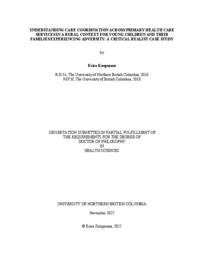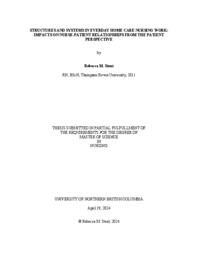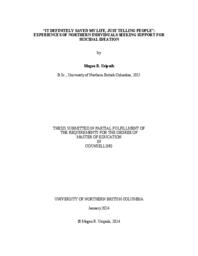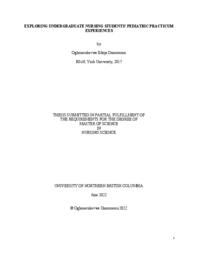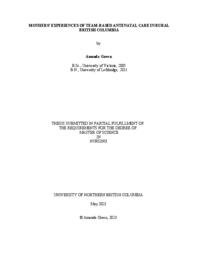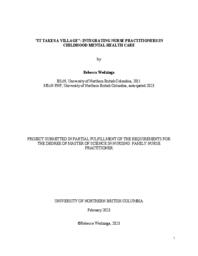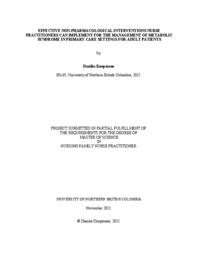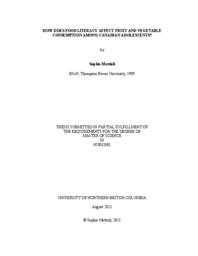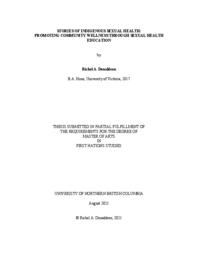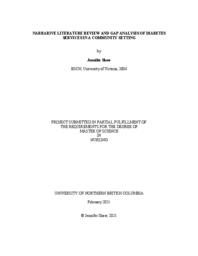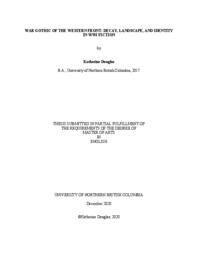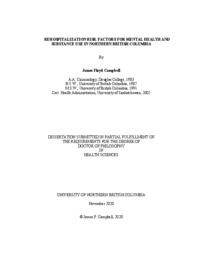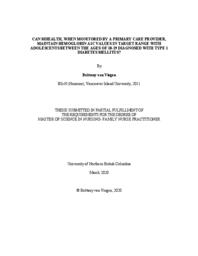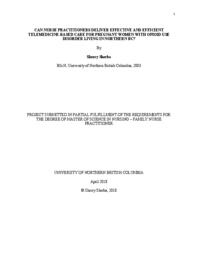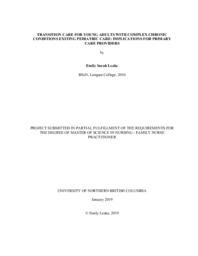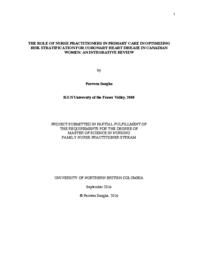Sanders, Caroline
Person Preferred Name
Caroline Sanders
Related Works
Content type
Digital Document
Origin Information
Content type
Digital Document
Origin Information
Content type
Digital Document
Description / Synopsis
This thesis examines the institutional structures and systems that coordinate everyday home care nursing work, and how they impact development of nurse-patient relationships from the perspective of patients. Using an institutional ethnographic methodology and incorporating patient-oriented research approaches, I interviewed patients and caregivers to gather rich descriptions of what actually happens in the day-to-day work of receiving home care nursing services, including the work of home care nurses that is visible to patients. Though institutional constraints related to efficiency and productivity can make providing relational care challenging, patients and home care nurses work around these ruling relations and find ways to meet the relational care needs of patients. The often-invisible labour of relational care needs to be recognized and valued at an institutional level to ensure home care nurses can meet the holistic care needs of patients and provide high quality, personalized, patient-centred care within a resource-constrained system.
Origin Information
Content type
Digital Document
Description / Synopsis
Suicide in northern British Columbia [BC] is an understudied but prominent health concern. This study aimed to understand the individual experiences of those seeking support for suicidal ideation in northern BC and, specifically, sought to understand what responses are perceived as helpful and not helpful. Using interpretative phenomenological analysis, five semi-structured interviews were conducted, resulting in four main themes found across each interview, each with two sub-themes. These four themes include: 1) Death Avoidance, where participants discussed how death and suicide were avoided, missed, dismissed, and hidden by themselves and others as well as the widespread silence around mental health and suicide in communities; 2) Power and Powerlessness, which describes the power that suicide held over the participants and their attempts at reclaiming some of that power; 3) Meaning and Meaninglessness, which explores the search for purpose and meaning each participant underwent; and 4) Connection and Safety, which discusses the complex interactions between connection and disconnection, and the ways that felt sense of safety, or the lack of, impacted connection and suicide. This study supports existing literature that describes the importance of safe and validating connections that allow for options, choice, and exploration of meaning. Moving forward, collaborating with individuals considering suicide in a trauma-informed manner that emphasizes respect, validation, power, and meaning is recommended.
Origin Information
Content type
Digital Document
Description / Synopsis
Practicum placements are the signature method used in undergraduate nursing programs to consolidate knowledge in practice. The literature review conducted before this study showed limited research on pediatric practices in undergraduate nursing education. This qualitative descriptive study, analyzed within Knowles’ (1977) adult learning theory framework, explored the practicum experiences of nursing students and the value they ascribed to their learning experience. The acute and community pediatric practicum experiences of 13 undergraduate nursing students and two recent graduates in British Columbia were explored using semi-structured interviews. Thematic analysis of interview data generated four overarching themes: relational practice, knowledge consolidation, identity formation, and exposure. Findings from the study indicated that nursing students valued pediatric placement opportunities that provided a variety of learning experiences and allowed them to work within their perceived scope. Information from this study can inform the planning and management of pediatric practicum experiences for nursing students in undergraduate nursing programs.
Origin Information
Content type
Digital Document
Description / Synopsis
Introduction: The health care system in British Columbia places priority on providing teambased primary maternity care. Participation of mothers in planning their care is an essential component of team-based care. Therefore, it is important to understand mothers’ experiences of team-based maternity care. Background: An integrated literature review resulted in 12 articles focused on mothers’ experiences with antenatal care delivered by a team of providers. Evidence highlighted the positive impact of team-based speciality antenatal care. Mother’s experiences of community team-based antenatal care were a notable gap in the literature. Objective: To explore antenatal care experiences of mothers living in rural British Columbia, where team-based antenatal care is known to exist. Method: To understand the perceptions of mothers' experiences of team-based antenatal care a qualitative methodology was used. An interpretive description approach combined semi-structured interviews with eight mothers purposively selected from two rural communities. Findings: Mothers played a key role in shaping the continuity of their care. Mothers collaborated with their providers across three types of continuity expressed within a team-based antenatal care context: management, informational, and relational. Building the relationship between the mother and a consistent provider (relational continuity) required clinical coordination (management continuity) and clear communication (informational continuity). From the mother's perspective, a specific team composition did not rate as highly as the connection to a consistent provider with whom they had respectful and trusting relationship. For all eight mothers a nurse and physician team-combination promoted continuity and patient-centeredness. Specifically, a primary care maternity nurse role supported stability in the mother's antenatal care. Gaps in continuity arose from experiences of antenatal care during the Covid-19 global pandemic and in the mothers’ mental wellness and pelvic floor health. Conclusion: When the mothers shared responsibility for continuity in care this strengthened the mother-provider partnership, regardless of which discipline was providing care. Mothers appreciated the continuity of carer – a provider who could develop a relationship with them during their antenatal care. The mothers valued providers who worked as part of a network, collaborating with a range of interdisciplinary providers to support the mothers’ antenatal care needs. Clinical Implications: There is merit in expanding discussions on the value a consistent provider working alongside mothers in rural team-based primary maternity care brings to mothers’ experiences of and engagement with antenatal care. Future research on how both continuity of care and continuity of a carer can support sustainable team-based antenatal care to improve outcomes is warranted in all community contexts.
Origin Information
Content type
Digital Document
Description / Synopsis
This literature review analyses how nurse practitioners can assist childhood mental health as led by the research question “What interventions can be implemented by NPs in a primary care setting for children 0-5 years old that are exhibiting internalizing/externalizing behaviours?” To answer this question, 10 research studies were analysed using a literature review matrix as guided using the steps of problem identification, literature search, data evaluation, data analysis, and presentation, which focuses on the interpretation of the findings, discussion, and recommendations for practice. Final recommendations are based around the two themes of parental change and health promotion through education and screening. Parental change is implemented through parenting classes, regular attendance of appointments and classes, and using local or online resources. Health promotion through education of childhood milestones and internalizing and externalizing behaviours and the consistent use of screening tools in well-child visits. This review emphasizes the benefits of an NP being involved in childhood mental health care.
Origin Information
Content type
Digital Document
Description / Synopsis
Sexually transmitted infections (STIs) are an increasing public health problem that affects all populations regardless of race or gender. Despite general increased prevalence, specifically young men who have sex with men (YMSM), between the ages of 15-26, are a high risk group accounting for 53% of all new cases. National and provincial guidelines recommend increased STI testing in YMSM in comparison to their female and non-MSM counterparts to reduce overall STI rates and prevent potential negative health outcomes. Although these guidelines exist, testing in this population remains low. This integrative literature review explores the barriers experienced by YMSM when accessing STI testing and informs strategies whereby Nurse Practitioners could optimize sexual health care in this population. A systematic search of the literature identified 11 key articles. These were analyzed using the Critical Appraisal Skills Programme tools, the Mixed Methods Appraisal Tool, and Scale for the Assessment of Narrative Review Articles. Three key themes emerged from the literature and are explored in detail: personal barriers, system-level barriers, and healthcare provider barriers. Recommendations based on the above themes with respect to facilitating sexual health education in YMSM and related practice improvement in NPs are identified. Normalization of sexual health through a life course approach and areas for further research are also highlighted.
Origin Information
Content type
Digital Document
Description / Synopsis
Metabolic syndrome consists of a combination of abdominal obesity, dyslipidemia, hypertension, and elevated glucose levels. Metabolic syndrome is prevalent in North America with upwards of 20% of adults meeting criteria for the condition. It is associated with increased risk of morbidity and mortality, particularly cardiovascular disease, stroke, and renal failure. Its prevalence and widespread consequences have major implications for overall burden of disease and cost on the health care system. First-line treatments for management of metabolic syndrome and its associated individual components require a multifaceted approach including nonpharmacological therapy. This integrative review seeks to answer the question: “What are effective non-pharmacological interventions nurse practitioners can implement for the management of metabolic syndrome in primary care settings for adult patients?” The Whittemore and Knafl (2005) method was followed to ensure a thorough process to which the findings and conclusion are described. There are few guidelines offering effective means of implementing non-pharmacological management of this disease. This review assesses the literature and identifies 13 articles which address effective non-pharmacological interventions in the management of MetS. These interventions were grouped into four categories including, dietary interventions, exercise interventions, psychological support, and a combined intervention approach. The lengths of intervention varied from 3 months to 5 years. Providers responsible for delivery of the interventions varied and were not limited to nurse practitioners. The outcomes of significance included improved anthropometric and serological measures, as well as improved participant motivation and behaviour change. For optimal outcomes of patients, the management of metabolic syndrome in a primary care setting requires a multifaceted and patient-centred approach.
Origin Information
Content type
Digital Document
Description / Synopsis
Background. Adolescents are losing the opportunity to observe and practice food skills since diets are shifting from home prepared meals made from basic ingredients to a diet comprised of ultra-processed foods, resulting in reduced consumption of minimally processed foods such as fruits and vegetables. Evidence suggests that engaging in food preparation during adolescence is associated with ongoing healthy dietary behaviours and food preparation practices into adulthood, thus developing food preparation skills in adolescence may help better support individuals to make health informed food choices. Food literacy represents the interdependent concepts related to the facets influencing dietary practices. The objective of the current study was to examine the association between food literacy and fruit and vegetable consumption (FVC) among Canadian adolescents. Methods. Guided by the food literacy framework developed by Thomas et al. (2019), a secondary analysis was conducted on the Canadian Community Health Survey, Rapid Response on Food Skills (Part 2) – mechanical skills and food conceptualization. The sample population (N=790) included all survey respondents aged 12- 17 years who responded to the survey questions that built the outcome variable: total daily fruit and vegetable consumption. Results. When compared to respondents who report low levels of food skill, respondents who reported high food skill levels in the ability to cook from basic ingredients (OR 1.84, 95% CI 1.12-3.02), freeze vegetables from raw (OR 1.50, 95% CI 1.00-2.24), and to adjust a recipe to make it healthier (OR 3.02, 95% CI 1.29-3.26) were more likely to consume fruits and vegetables five or more times a day. Respondents who came from households where the highest level of household educational attainment was trades had lower odds of consuming fruits and vegetables five or more times a day compared to households where the highest level of educational attainment was a bachelor’s degree or higher (OR 0.34, 95% CI 0.14-0.81). Within the logistic regression model, significant relationships were found between FVC and a respondent’s sex (p=0.04), perceived eating habits (p<0.001), and highest level of household educational attainment (p=0.02). Discussion. Significant relationships between FVC and food literacy were evident in food skills that were multifaceted, requiring that adolescents have the ability to perform a number of basic food skills and reflective of several food literacy attributes. The relationships found between multifaceted food skills and adolescent FVC suggest that food literacy attributes are interconnected and have reciprocal relationships. Conclusion. Dietary behaviours are influenced by multiple factors. Study findings suggest that higher levels of adolescent food literacy, as reflected in multifaceted food skills, have the potential to positively impact their FVC. However, when societal factors are controlled for, food skills were not found to have a significant relationship with adolescent FVC, suggesting that factors outside of the control of the individual have the potential to minimize the influence of individual food literacy characteristics on adolescent FVC. Future food literacy programs should be inclusive of adolescents from all SES and should aim to teach and evaluate food literacy attributes that build more complex food skills.
Origin Information
Content type
Digital Document
Description / Synopsis
Indigenous communities and peoples have experienced erosion of their sexual wellness since contact with European peoples. Effective sexual health education is a human right shown to be an important part of overall health and wellness. Little research has been done on how to develop and implement sexual health education for Indigenous populations. This study utilizes an environmental scan to gain a comprehensive understanding of programming available for Indigenous peoples in BC, coupled with conversational style interviews with community storytellers to highlight effective practices. The findings of this research demonstrated that programs focused on promoting healthy sexuality generally or preventing HIV/AIDS and STBBI transmission while promoting safety and access to culture, utilized peer led approaches, and focused primarily on delivering services to youth. Storytellers demonstrated a strong passion for building relationships with participants and communities through engaging, accessible, and relevant sexual health education.
Origin Information
Content type
Digital Document
Description / Synopsis
Pediatric patients in northern BC have some of the highest asthma prevalence rates compared to children in other areas of the province. Adequate parental health literacy skills are particularly important to make informed health management choices when caring for children with asthma. In this project, a gap analysis process was followed, and three evidence-informed practice gaps related to pediatric asthma care were identified. Findings highlight the need for increased asthma education and parental health literacy resources to address concerns mentioned during stakeholder engagement. Four key recommendations were formulated regarding parental health literacy assessments, clear language requirements for written asthma materials, access to specialized care resources, and adaptation of current asthma education models. In conclusion, the development of a working group that includes asthma and health literacy stakeholders, is the next step to address the findings of this project and improve the overall asthma health outcomes for children in northern BC.
Origin Information
Content type
Digital Document
Description / Synopsis
The goal of this project was to outline best practices regarding the organization of diabetes care and services in the community in relation to the local context of services in Squamish, BC, Canada to create a foundation for future quality improvement work. The theoretical framework of personcentered care is essential to chronic disease management and underpins this work. The methods include: 1) A narrative literature review consisting of a database search, and 2) A gap analysis consisting of local data and an environmental scan. The Chronic Care Model is an evidence-based integrated care framework used to organize the findings of the narrative literature review and the gap analysis and to frame the recommendations (Clement et al., 2018). Based on the findings, evidence-based recommendations were created specific to the context of diabetes care in Squamish, BC creating the opportunity for meaningful future quality improvement work.
Origin Information
Content type
Digital Document
Description / Synopsis
Attention-deficit/hyperactivity disorder (ADHD) is a controversial diagnosis that is debated in public and professional spheres. However, the experiences of Aboriginal peoples have largely not been included in this debate. Considering that reactions to trauma may include hyperactivity and attention-deficits, and that mental health is defined differently in different cultures, this is arguably problematic. This research uses a qualitative exploratory approach embedded in an anti-oppressive social work research framework to explore the experiences of four urban Aboriginal mothers of children diagnosed with ADHD in Northern British Columbia. It was found that Aboriginal caregivers experience many challenges already recorded in the literature, and that they also grapple with the impacts of colonialism and intergenerational trauma in different ways. When considering the principles of allyship and anti-oppressive practice, this raises ethical questions about where the burden of responsibility lies, as well as how ADHD is currently defined and used in practice.
Origin Information
Content type
Digital Document
Description / Synopsis
The First World War was a unique and unrepeatable Gothic event, and so, this thesis examines its modern and postmodern literary accounts within the War Gothic framework. Analysing Erich Maria Remarque’s All Quiet on the Western Front, Gabriel Chevallier’s Fear, Sebastian Barry’s A Long Long Way, and Joseph Boyden’s Three Day Road, it looks at the relationships of transformative states; specifically, the decomposition and destruction of the body, the landscape, identity, and masculinity along the trenches of the Western Front. Moreover, this thesis explores how the Gothic nature of WWI affects identity politics in the four novels according to personal, cultural, and national authorial subject positions. The War Gothic unites the German and French narratives with the previously unrepresented, and now re-imagined, Irish Catholic and Indigenous Canadian war experiences for the Gothic communicates the ineffable complexities of human nature and of war.
Origin Information
Content type
Digital Document
Description / Synopsis
Mental health and substance use (MH&SU) rehospitalization rates are used as indicators of treatment quality, to reduce costs, and measure efficacy. Research on this topic in rural Canadian hospitals and communities is lacking. This study used secondary data on 5159 patients (age 15 and older) hospitalized with International Classification of Disease (ICD) F code MH&SU diagnosis. These patients had 9103 admissions to 18 hospitals in Northern British Columbia during a five-year period, April 1st, 2010 through March 31st, 2015. ANOVA and Tukey Post Hoc tests were used to examine associations of two performance measures with five patient factors; community size, Indigenous culture, relationship status, employment status, and ICD F code diagnoses. The first measure was number of hospital readmissions. Of the 5159 patients with 9103 admissions, 3482 (67.6%) had one hospital admission during the five-year period. The remaining 1677 (32.4%) patients had 3944 (43.3%) of the hospitalizations). Patients whose cultural identity was Indigenous had over-representation and increased readmissions. Patients who were single and never in a relationship had increased hospitalizations. Patients whose ICD F coding for schizophrenia or psychosis had increased hospitalizations. The second measure was wait time for community MH&SU follow-up. Of the 5159 patients, 4512 (87.5%) had contact with community MH&SU during the five-years. Urban communities with specialized MH&SU services had reduced wait times for follow up. Patients whose cultural identity was Indigenous had longer wait times for community MH&SU follow-up. Patients who were divorced or separated had longer wait times. Patients with ICD F coding for schizophrenia or psychosis had shorter wait times for follow-up. The relationship between hospital readmission and community MH&SU follow-up was examined using logistic regression with the five factors. An inverse relationship was found between the two performance measures. Patients who did not have community MH&SU follow-up within 30 days had reduced odds ratio of readmissions, whereas patients who had follow-up within 30 days had increased odds ratio for readmissions. Although the study finds support for patient risk factors, evidence suggests approaches like a Decision Support Tool (DST) might provide reliability for intervention, and resource planning, as well as timely intervention.
Origin Information
Content type
Digital Document
Description / Synopsis
Difficulties in mentalization may be a developmentally based foundation for interpersonal problems in Borderline Personality Disorder (BPD). Fonagy and colleagues have developed a theoretical framework whereby relationships between difficulties in mentalization and other core characteristics of BPD (i.e., insecure attachment, intrapersonal emotion dysregulation and identity diffusion) may underlie interpersonal problems. However, most of the published work on these aspects of the framework have been theoretical in nature. The aim of the study was to investigate this framework and extend it by including interpersonal emotion dysregulation. Simple and multiple mediation analyses were performed with a convenience sample of 64 undergraduate students. Results indicated that hypomentalizing mediated the relationship between BPD symptoms and interpersonal problems. No significant mediators were found between insecure attachment and interpersonal problems or between mentalization errors and interpersonal problems. Limitations include the sample size and the lack of a negative emotion induction and recommendations for future research are suggested.
Origin Information
Content type
Digital Document
Description / Synopsis
Diabetes mellitus is an international epidemic affecting millions of individuals worldwide. In Canada, an estimated 3.4 million individuals are living with diabetes mellitus— approximately 9.3 percent of the total population (Canadian Diabetes Association, 2018). A high prevalence of diabetes mellitus comes with a substantial cost; the direct annual cost associated with diabetes mellitus is expected to reach 3.1 billion dollars by 2020 (Bilandzic & Rosella, 2017). The Canadian Pediatric Society recognizes that there are currently 33,000 children and adolescents aged 5-18 years old living with type 1 diabetes mellitus (T1DM) (as cited in the Diabetic Children’s Foundation, 2018). As children and adolescents with T1DM are in the process of developing physically and psychologically, they are at an increased risk of developing complications of diabetes that require short to long term attention and monitoring. The utilization of mobile technology to provide healthcare services is commonly referred to as mHealth. Such technology offers an opportunity to address the challenges of chronic disease management with this technology- intelligent population (Kitsiou, Paré, Jaana, & Gerber, B. 2017). As a component of the Master of Science in Nursing- Nurse Practitioner program at the University of Northern British Columbia, the following is an integrative review to answer the research question: Can mHealth, when monitored by a primary care provider, maintain hemoglobin A1c values in target range with adolescents between the ages of 10-19 diagnosed with type 1 diabetes mellitus?
Origin Information
Content type
Digital Document
Origin Information
Content type
Digital Document
Origin Information
Content type
Digital Document
Origin Information
Content type
Digital Document
Origin Information
Content type
Digital Document
Origin Information

